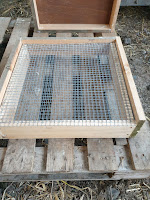Week 25 - Conclusion
Learning to build a Beehive I have discovered that learning to build a beehive is not as straightforward as maybe building a birdhouse for example; as a hive needs to be built to an exact standard. This is because bees are quite particular about their home structure, also a poorly constructed one causes problems for the beekeeper as well. It is important to check for signs of a new Queen or disease to ensure the colony’s survival. So, if the hive is not constructed properly, all kinds of problems could arise and make inspections more difficult and ultimately put the colony at risk. Rather on focussing on how to design a radical new shape of hive, I did some research on existing models and it was apparent that there are four main types of hive that continue to be popular amongst beekeepers today; from the reasons stated in my blog, I opted for the British Standard hive to build. Once I had chosen the design, it was straightforward enough to set out plans and measurements fo...





